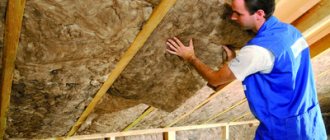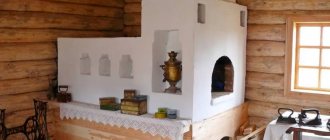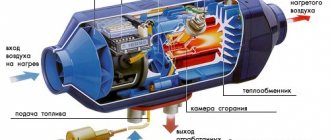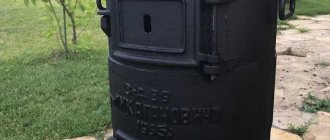Fire without smoke
It was no coincidence that Nikolai Petin came up with the idea of heating the stove with water.
Nikolai Nikolaevich worked for many years as chief engineer in a special department that was involved in extinguishing endogenous and exogenous fires.
“The coal didn’t want to go out, even in the absence of oxygen,” he says. “And then I realized that water could also burn.” You can’t remove it from the rock, you can’t create drainage. And when heated, it decomposes into hydrogen and oxygen.
Nikolai Petin began experimenting in the kitchen. I placed an old aluminum kettle on the stove, sealed it with clay, and put a rubber tube on the spout. When the water began to evaporate, he pointed the pipe into the blower:
— The stove started working differently: the color of the flame changed, the tongues became blue instead of red. The heat is greater, and while steam is escaping from the spout, the coal burns more slowly. And I understood what was going on.
The essence of the know-how is that you can do without a blower, through which draft usually occurs. Instead, there is a container with water, and steam is fuel. The main thing is not to overdo it with “fuel” and make sure that all the water does not evaporate. A retired geologist made the first experimental furnace for himself. The second, improved one, was for a friend who lives next door in a three-story house. Previously, he used about five buckets of coal a day, but with the advent of the miracle stove - three times less.
“What usually happens,” Petin explained, “coal falls into the ash pit and smolders there, releasing carbon monoxide.” And so that the stove does not go out, we are forced to open the vent. As a result, we put a noose on ourselves with our own hands - we burn the oxygen we breathe. In my stove, unburnt lumps of coal fall into a bowl of water and go out. In this case, the coal remains coal, and it can be used again later.
Petina technology can be used not only in home ovens, but also in boiler rooms. There is no need to break or change anything radically. It is enough to install special devices into existing boilers. There will be enough evaporation to avoid using clean air. Can you imagine how much carbon monoxide and soot emissions into the atmosphere will decrease? And how much process water can be burned, thereby relieving wastewater treatment plants, and not pollute water bodies.
— I heard that the Japanese store snow to later use it as fuel. They explain that roadside oils supposedly accumulate in the snow. Or maybe they have already figured out how to burn water? - suggests the inventor.
Injecting water into the burner
Why else would you need to supply additional water? she will only eat the power
Absolutely not like that. On the contrary, it will add a lot.
With water it’s not so simple - within reasonable limits it increases the power output. An example is water injection in oil burners, coal boilers, diesel engines. The mechanism of action of water is clearly different. With oil, I understand this matter this way - the smaller the size of the combustible particles, the more completely they should burn - the water in the torch instantly boils and the steam crushes the oil droplets into dust, the result is complete combustion. Anyone who has used the “miracle oven” during testing is familiar with the effect of water/antifreeze in oil.
That's exactly what it is! Last winter, my friend and I carried out an experiment on a stove that was working. The stove is approximately the size of a regular gas stove and is made of stainless steel. There is a cylinder inside it. There are a lot of holes drilled in the cylinder, approximately 5 mm in diameter. At the bottom of the cylinder there is a cast iron frying pan with a diameter of about 300 mm, the same diameter as the cylinder itself. The cylinder is blown by a fan through a diffuser pipe. The oil is fed into the oven into the frying pan by the drip method, through a copper tube. In one hour of operation, the furnace consumes 1 liter of waste (this is how we set up the supply). While the furnace was operating, the inner cylinder heated to a barely noticeable red glow. After turning off the light, we took a photograph of the furnace in operation. The photo showed a faint reddish stain on the cylinder. During the second hour of the experiment, water was added to the frying pan by dropper. The calculation was 1 liter of oil per 1 liter of water. The oven heated to a faint crimson color, and the cylinder inside completely glowed to a bright red glow. Also, the stainless steel exhaust pipe with a diameter of 100 mm and a length of about 2 meters became a faint crimson color. We turned off the lights again and took a photo. This time in the photo there was a spot about 6 times larger and more intense in its brightness. The heat from the stove was many times greater than the first experiment. It was a bit hot (hot) to stand at a distance of 2 meters. In our case, with the experiment with the addition of water, the efficiency of heat transfer from burning 1 liter of waste increased very significantly. In my subjective opinion, no less than 4 times, and maybe more!.. The temperature in the workshop increased noticeably and became close to comfortable - about 20 degrees. Unfortunately, the photo was not saved... The only drawback of operating the stove with water is the greatly increased noise from the draft in the exhaust pipe and the “crinkling” from the water itself in the stove. After an hour of work, the furnace was extinguished to check what happened to the coke and soot inside. The oven and frying pan below were absolutely clean! All the soot has burned out! There was no soot deposits in the exhaust pipe, unlike work only on oil recovery. The furnace worked successfully all winter in this car workshop.
An old stove maker grandfather taught us how to handle the stove and heat it correctly
Our family recently purchased a village house that has a stove. We had never used one, so we found a stove-maker grandfather in the village. He talked about the types of firewood (which ones are better to burn and which ones are worse) and gave some more tips on how to use the stove so that it serves for a long time. We learned a lot of useful things from him, thanks to him!
As it turned out, if you handle the stove and firewood correctly, you can reduce fuel consumption by 15-20 percent. You can also improve heat transfer and prevent increased soot formation in the chimney. At the same time, the service life of the stove largely depends on following the rules.
What kind of firewood is preferable?
It is best to take firewood from hard, deciduous trees. When they burn, no resin is released, and the high combustion temperature is maintained without problems. An additional advantage is that soot remains to a minimum inside the chimney.
It is not advisable to heat the stove with garbage; it is also bad to use spruce and pine wood. On the contrary, it is good to heat with sawdust. Briquettes are also used; they are made from peat or wood. The fuel should have a moisture content of about 20 percent. It is present if the firewood is stored in a dry room for a year.
How to heat correctly?
To reduce wood consumption and improve combustion, the stove maker advised doing the following:
- You need to put logs into the stove that are approximately 5 cm shorter in size than the length of the firebox. If, when preparing firewood, you make it approximately the same size, it will be much easier to burn.
- The logs are laid in such a way that there are gaps for air.
- Although the stove can, in principle, be heated with raw wood, this is fraught with the release of tar with smoke and in considerable quantities. In this regard, it is better to deal with dry fuel (no more than 25 percent humidity).
And finally - about how to start lighting the stove.
Posts 1 page 30 of 31
Share108-09-2010 11:43:14
- Author: DAN
- Administrator
- From: St. Petersburg
- Registered: 06/22/2007
- Invitations: 0
- Posts: 1678
- Respect: +17
- Positive: +20
- Gender: Male
- Age: 60 [1961-03-24]
- Time spent on the forum: 11 days 4 hours
- Last visit: 13-10-2021 10:52:12
Others! Tell us how furnaces with a water circuit are operated in winter. Filling, draining water, what to pay attention to during installation. Until I bought a stove, I need to think about how to heat the water in winter. Electric water heater. I already have it (they gave me a used Ariston), but the electricity is often turned off and I need to have an alternative. I moved the topic from stoves to water supply. At the same time, I re-read the threads here and realized that the question needs to be formulated more specifically: 1. There is no winter water supply and there is no sign of it yet. How to fill with water? An open tank in the attic and filling it with buckets? Place a tank with a lid on the stove and drain hot water from there? 2. If you have a summer water supply (submersible pump, in a well), will it be possible to pump water? 3. If there is a register in the stove, you won’t be able to fill it with water in winter, what could happen to the register in a dry oven without water? In general, my head is torn - I can’t imagine how I’ll wash myself in winter. How do people wash if there is no water at all, like the well is frozen. Is snow melted in a tank on a stove?
Share208-09-2010 15:01:27
- Author: WIK
- Sort of a chef
- From: MOSCOW, RASSUDOVO
- Registered: 14-06-2007
- Invitations: 0
- Posts: 1726
- Respect: +10
- Positive: +25
- Age: 62 [1959-04-20]
- Time spent on the forum: 10 days 23 hours
- Last visit: 19-10-2021 19:10:07
I HAVE: A remote tank in my shower connected to a register on a pipe. (well, you saw it in the photos). I fill the fifth year by carrying water in buckets (5-7 minutes of work)
. At the same time: there is a tank with a heating element dragged into the attic, for which it is necessary to conduct water wiring from the baby pump from the well, and which must be covered with a frame with foam plastic for use in winter conditions. But. Five years of doing this is a waste of time, because the “temporary” operation of the existing tank discourages the desire to do anything - completely! I don’t have an Anton ship, but a bathhouse for myself, well, sometimes (a couple of times a year) for guests. Not bayare. They can drench themselves from a ladle or just from a basin. You get steamed, your eyes look like a cancer, you go into the sink, wash your hair, pour out a bunch of water - 3 minutes, sit down, and think: well, why the hell do I need this tank in the attic. (It’s only needed for one purpose: (when you don’t heat the bathhouse, just stupidly wash yourself.) It’s more difficult for you - you have a storage heater. It’s an amazing and wonderful thing. But think of it like the supply pipes from a well, entangled with wire, like a “warm floor.” I drain it in the winter, obviously. (I forgot once - I changed the faucet, it broke my mother’s) Heat, heat the register, the tank without water - no problem! Only the stainless steel will show tarnished colors, nothing more. No distortions, kinks, melting of the insulation at the joints it won't. In winter I usually do this: first I heat up the stove without water in the tank and register for about 10 minutes, then I pour water from a bucket into the tank. Inside, something pops and explodes, like a bomb, steam and that's it. Snow in the tank "What could be simpler? A couple of minutes and water. Just look for cleaner snow
Share308-09-2010 16:10:04
- Author: DAN
- Administrator
- From: St. Petersburg
- Registered: 06/22/2007
- Invitations: 0
- Posts: 1678
- Respect: +17
- Positive: +20
- Gender: Male
- Age: 60 [1961-03-24]
- Time spent on the forum: 11 days 4 hours
- Last visit: 13-10-2021 10:52:12
I wouldn’t want an open tank in the sauna: there will be a lot of steam, but I want to warm myself up dry more often. I’ll probably do it like you: I’ll hang an open tank higher in the dressing room and make the wiring so that water flows to both the shower in the summer and the drain into the ladle in the winter. I’ll warm up the stove and register, melt the snow, pour some water. Our snow is clean, even though it’s 30 km from the city. And in the summer you can turn on the electric water heater when the water supply is running, otherwise you are too lazy or don’t have time to heat the water heater, you need to keep an eye on the fire, and then the automation will heat up as it should. Thanks Victor, you set me straight,
otherwise, the closer to the first firebox, the more doubts there are, because it will be more difficult to redo it. Now, the electrical wiring already had to be re-arranged due to the fact that the layout was slightly changed.
Share415-09-2010 15:32:08
- Author: Alka
- Participant
- From: Moscow, Lobnya
- Registered: 01/31/2008
- Invitations: 0
- Posts: 97
- Respect: 0
- Positive: 0
- Female gender
- Age: 59 [1962-05-31]
- Time spent on the forum: 21 hours 15 minutes
- Last visit: 07/24/2014 12:57:25
If there is a register in the stove, you won’t be able to fill it with water in the winter, what could happen to the register in a dry oven without water? In general, my head is torn - I can’t imagine how I’ll wash myself in winter. How do people wash if there is no water at all, like the well is frozen.
I’ll tell you how it is for me: There are 2 tanks of water in the washing department. The top one is for hot - connected to the register built into the oven (Harvia oven). In winter, I don’t drain the water and I can hardly even imagine how to do it from the register, so there is a convector near the stove. The first winter the water froze, it was very scary to heat it, what if the register inside the stove melted?
We wash with buckets and ladles, no one complained.
Share515-09-2010 15:53:11
- Author: DAN
- Administrator
- From: St. Petersburg
- Registered: 06/22/2007
- Invitations: 0
- Posts: 1678
- Respect: +17
- Positive: +20
- Gender: Male
- Age: 60 [1961-03-24]
- Time spent on the forum: 11 days 4 hours
- Last visit: 13-10-2021 10:52:12
In winter, I don’t drain the water and I can hardly even imagine how to do it from the register, so there is a convector near the stove.
Hello Alka! It’s quite rare, something started to happen
For some reason I think it’s a shame not to drain the water. Almost all of my barrels already have a round bottom, because I didn’t drain all the water, and hello, frosty -10 C and that’s it, take it ready. Your steel is probably thick. Do you pour water into tanks in buckets or with a pump?
Share615-09-2010 15:59:53
- Author: Alka
- Participant
- From: Moscow, Lobnya
- Registered: 01/31/2008
- Invitations: 0
- Posts: 97
- Respect: 0
- Positive: 0
- Female gender
- Age: 59 [1962-05-31]
- Time spent on the forum: 21 hours 15 minutes
- Last visit: 07/24/2014 12:57:25
Hello! Rarely, because there are no questions, and I don’t know how to build
You probably can’t just drain the water from the register in the furnace, maybe you need to blow it out. It is necessary to unscrew the hoses and adjust something. I am not capable of such a feat. That's why my convector heats up there.
PS: I didn’t measure the thickness of the steel. Water - in buckets. I have 2 tanks of 120 liters each. Go for water 10 times. (This is for my husband, more for me
) You can stupidly attach the hose to the water. But rusty water from the water supply in the summer, and from the house after the filters are not convenient in winter.
What is best to use for cleaning a chimney?
Chimney maintenance needs to be done periodically. Soot and resin deposits are removed from it. There are following reasons for this:
- The internal lumen becomes overgrown, causing traction to deteriorate and, accordingly, heat transfer decreases.
- If there is insufficient draft in the chimney, then a reverse draft effect may occur. Instead of going outside, the smoke will return indoors, which is the cause of carbon monoxide poisoning.
- Having reached a critical level, the soot ignites. Essentially, a micro-explosion occurs inside the chimney. During combustion, a lot of heat is released and heating occurs up to 1200 ° C. Then the chimney requires major repairs.
What type of wood is best for firewood?
Different types of wood differ from each other in their calorific value and combustion characteristics. In this regard, when choosing fuel, you need to understand the performance characteristics of firewood.
- Pine has a high combustion temperature. The reason for this is the high resin content. This rock suggests many voids where tar deposits are present. When burning, they produce micro-explosions, sparks and ignited pieces of wood fly away.
- Spruce is less efficient in a firebox than pine. It contains less resins. Splitting wood is easy, but when burning the tree smolders and smokes. These conifers can be used for heating only in extreme cases.
- Alder. The main feature is the ability to burn without forming soot. At the same time, during combustion, deposits in the chimney will also be burned out. Such characteristics are unique to aspen.
- Poplar. It burns out quickly without providing enough heat. It should not be used to heat a bathhouse, but it is quite suitable for a home.
- Birch. Burns hotter than beech with acacia and oak. But there is also a drawback, and a significant one. It is necessary that there is sufficient air flow into the combustion chamber. Otherwise, there will be no heat, but only tar and smoke on the walls of the chimney.
- Oak. It is distinguished by its high density and ability to release heat. Its characteristics are similar to ash and also resemble beech. Oak wood is quite heavy when splitting.
- Maple. Its wood burns quickly without forming coals, as a result, there is a need to constantly add fuel. It's like burning linden wood.
- Apple trees. Like other fruit species, it pricks well and produces enough heat when burning. Apple firewood is also preferred because of the pleasant smell in the room.
Here's what else the stove maker said.











